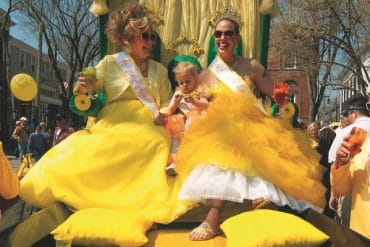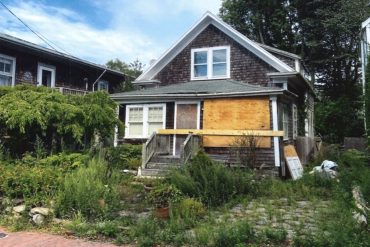 It was the strongest storm to make landfall in recorded history. Winds screamed up to 235 miles per hour, ripping century-old trees from their roots and turning entire city blocks into piles of rubble.It packed the fury of an F4 tornado and category-five hurricane. The storm surge climbed thirteen feet, wielding tsunami-sized waves that crashed through second story windows. The human toll was no less staggering. At least six thousand were dead, hundreds of thousands of others were missing or displaced. One of the witnesses to Typhoon Yolanda’s devastation to the Philippines this past November was Nantucket resident, Terry Pommett. This is his story.
It was the strongest storm to make landfall in recorded history. Winds screamed up to 235 miles per hour, ripping century-old trees from their roots and turning entire city blocks into piles of rubble.It packed the fury of an F4 tornado and category-five hurricane. The storm surge climbed thirteen feet, wielding tsunami-sized waves that crashed through second story windows. The human toll was no less staggering. At least six thousand were dead, hundreds of thousands of others were missing or displaced. One of the witnesses to Typhoon Yolanda’s devastation to the Philippines this past November was Nantucket resident, Terry Pommett. This is his story.
Terry Pommett started going to the Philippines four years ago. The longtime Nantucket- based photographer had spent his life traveling the world. He was an army brat growing up, and the rhythm of pin balling from place to place never left him. Yet much like when he discovered Nantucket over forty years ago, Pommett found himself returning again and again to the Philippines. For a photographer, the Philippines were mesmerizing. All the colors and character of nearly 100 million people spread over seven thousand islands could keep his camera clicking for a lifetime. He loved the nature, the culture and the tropical lifestyle, but there was another reason why Terry Pommett returned to the Philippines this past fall.
Gemma Albon was working as a floor manager at a department store in Tacloban City on the island of Leyte when an American walked in. They started chatting and then he asked her out to dinner. Before long, Pommett and Albon were traveling throughout the Philippines together. They went island hopping, snorkeling with whale sharks in Southern Leyte, caving in Sagada, hiking the Banaue Rice Terraces and exploring the Ifugao tribal regions of Luzon. After spending the summer on Nantucket, Pommett had now returned this November to the Philippines to travel with Gemma again. She planned to take off from work and they would set out on another adventure. Mother Nature, however, had other plans.
On November 2nd, a tropical depression in the West Pacific began kicking up thirty-mile-per-hour winds. Forming over the open ocean, the weather system sucked energy from the warm Pacific and strengthened with no landmass in its way to slow it down. Passing west of the Marshall Islands, where the US Army once tested nuclear arms, the tropical depression graduated to a tropical storm. When the winds exceeded seventy-five miles-per-hour, the Japanese Meteorological Agency labeled it a typhoon. Internationally the category-five hurricane was known as Haiyan, but among the Filipino people it would be called Yolanda.
On November 5th, Yolanda was bearing down on Tacloban City. Pommett decided to leave the city and fly to the safety of Manila to avoid the storm, while Gemma planned on staying behind to weather it with her family on the small island of Balud, some eight and a half hours northeast of Tacloban. Pommett advised her to stay in the city. He thought the storm was sure to wallop the coast, and the city of Tacloban would provide her more protection than on the coast where her family lived. After some debate, Gemma appeased Pommett and agreed to stay in Tacloban as he advised. The two said their goodbyes and Pommett flew to Manila. The day before the typhoon hit Tacloban, Gemma sent a text message to Pommett, joking: “Will you rescue me if I’m in danger?” Neither could imagine what was to come.
When Yolanda made landfall three days later it was the strongest typhoon in recorded history. Winds screamed at a sustained 195 miles per hour. Gusts plucked palm trees from the ground like dandelions. Waves slammed through two-story windows, and those huddling in their homes thought they were being consumed by a tsunami. Yolanda first struck Guiuan, Samar, and then the super typhoon descended upon Tacloban with all its fury. Gemma was in Tacloban — or so Pommett thought.
For days after the storm, Pommett holed up in his high-rise apartment in Manila in a state of extreme anxiety. The news trickling in said that much of Tacloban had been destroyed and the number of dead was in the thousands. Ninety percent of the buildings, both homes and businesses, lay in heaps of rubble. Along the coast, gigantic ships were tossed onshore by the storm surge. The only sign of the airport was the runway. There was no electricity, no cell phone service, and no clean water supply. If Gemma wasn’t in a shelter Pommett feared she was dead. When he couldn’t handle his anxiety any longer, Pommett decided he’d leave Manila and volunteer in Cebu, the island south of Leyte. He was preparing to leave when his cell phone buzzed with a text message. It was from Gemma: “Can you help me?”
Pommett had no way of knowing when Gemma had sent the text message. She might have sent it before the storm struck and he was only receiving the message now. Where was she? What could he do to help? Pommett texted and called, but the phone lines went dead again. He decided to stick to his plan and volunteer at Cebu. If Gemma were alive, he’d wait for her next text message there. Four days later, while attending a Christmas vigil, just before heading off to volunteer, Pommett’s phone buzzed again. Gemma was alive, but she needed help.
Just before the storm hit, Gemma had decided against staying in Tacloban and traveled to her family’s house in Balud. The decision probably saved her life. When Yolanda hit Balud, Gemma and her family hid beneath two tables lashed together in the kitchen. The roaring wind ripped off the roof and the walls crumbled around them. For seven hours, the Albon family of nine huddled under the wooden tables as the apocalypse raged overhead.
When the eye of the storm passed over Balud, Gemma and her family ran to a nearby church that had been turned into a shelter. They remained there for six hours until the storm finally passed. When Gemma emerged from the church, the island was unrecognizable. Nearly every home had collapsed and the beautiful palm trees that once brought shade to Balud had all been snapped in half. The hundred-year-old bread tree that stood over Gemma’s front yard had slammed down just feet from where she and her family were hiding. The sun glared down and the heat was blinding. There was no food or clean drinking water. Gemma and her family banded together with their neighbors to hunt for crabs and clams to try to survive until help could reach them. That was when Gemma sent her text message to Pommett.
Now in Cebu, Pommett volunteered by creating relief packets of rice, crackers and sardines. Vacationers and tourists from all over the world joined him in the effort. Meanwhile chaos spread throughout the Philippines. The Philippine government’s response to the storm was terribly slow, and disorder seized much of the impacted areas. In Tacloban, prisoners escaped and looting was rampant. Police told the prisoners that if they didn’t return to their cells, they would be shot on sight.
Like many other Filipinos, Gemma made the daylong walk to Tacloban in hopes of recovering her belongings. The bodies of people and animals were strewn in the fields. She waded through knee-deep water where body parts floated amongst the debris. The stench was nauseating. In the city, when darkness came, so did lawlessness. Groups of hungry men trolled the streets for food. Gemma did not linger. After finding most of her possessions destroyed or looted in the city, she trudged back through the rubble, through the bodies, through the night to her family back in Balud.
Help came to the Philippines by way of an old friend, the United States. The USS George Washington steamed into the Gulf of Leyte along with 13,000 servicemen. Fifty other US military ships and aircraft followed in its wake. They immediately cleared and reopened the airport where thirty-four specially designed helicopters known as vertical lift aircraft flew aid and medical supplies to remote islands. One thousand American troops were deployed directly to disaster areas to distribute aid, clear roads and evacuate survivors. While twenty other nations would also come to the aid of the Philippines, they would all be dwarfed by the American effort. (China initially pledged a measly $100,000.) For the first time in a long time, Pommett felt deep pride for his country.
Eleven days after the storm, Pommett took up his own rescue mission. He learned that Gemma was in Balud, and that she and her family were in desperate need of food. Pommett filled two duffel bags with rice and other non-perishables and boarded a commercial boat headed west to Leyte. Nearing the shoreline, he was aghast at what he saw. The destruction was baffling. This once gorgeous island was now a horrifying mess of twisted metal and distraught humanity. There was, however, one beautiful sight waiting for him at the dock: Gemma had traveled overnight to meet him. After reuniting, Pommett and Gemma hired motorcycle taxis to take them to her family. The journey took six hours and cut through the heart of the hardest hit areas. The scene was so devastating that the prolific photographer had trouble even raising his camera.
When Pommett and Gemma finally reached her family, he found them stripped of all their possessions. They had no food, no money and no home. Pommett did everything he could to help, shuttling food and supplies back and forth and even trying his hand at catching crabs and clamming. In the weeks that followed, he purchased timber and metal for the Albons to rebuild their home. Like millions of others, the journey back to life had just begun for Gemma. Even months after Yolanda hit, much of the impacted areas were still without power and left in the darkness.
But there was hope shining out from the abyss. Terry Pommett was inspired by the show of solidarity shared amongst the Filipino people. They’d survived one of the worst natural disasters in human history, dug family and friends out from the rubble, scraped together whatever they had left, and began to rebuild. They were proof that even in the darkest days, the glow of the human spirit might flicker, but it can never be extinguished.





